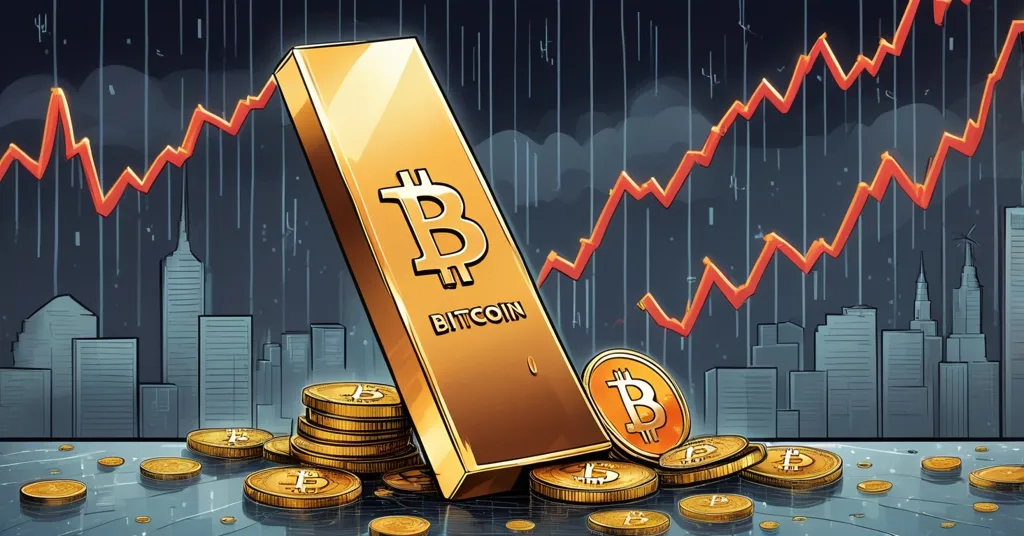JPMorgan Slams Bitcoin’s Safe-Haven Claims: Gold Outshines in 2025 Turmoil

JPMorgan Challenges Bitcoin’s Safe-Haven Status Amid Economic Turmoil
JPMorgan’s recent report has cast doubts on Bitcoin’s ability to act as a reliable safe-haven asset during economic turbulence triggered by tariff-induced market volatility. The analysis highlights that traditional assets like gold and the Japanese yen have outperformed Bitcoin, drawing investors seeking stability amidst uncertainty.
- JPMorgan: Bitcoin fails to act as safe-haven during tariff volatility.
- Gold and yen attract investors, while Bitcoin struggles.
- Bitcoin ETFs witness outflows, contrasting with gold ETFs.
- Bitcoin down 29% against gold in 2025.
- Frank Giustra questions Bitcoin’s “digital gold” narrative.
- Tom Lee highlights Bitcoin’s versatility in market roles.
- Mike Novogratz remains optimistic about Bitcoin’s future.
JPMorgan’s analysis comes at a critical juncture when economic uncertainty has investors on edge. Tariff-induced market volatility typically drives capital towards safe-haven assets, but instead, it has underscored Bitcoin’s challenges. According to the report, “Bitcoin has failed as a safe-haven asset amid the recent tariff-induced mayhem.” This stark assessment contrasts with the performance of traditional safe-havens like gold, which has not only held steady but attracted more investors during these turbulent times.
Exchange-traded funds (ETFs) tied to Bitcoin have seen persistent outflows, while their gold counterparts enjoy steady inflows. This investor behavior highlights a preference for the tried-and-true over the digital newcomer. In fact, Bitcoin’s value has declined roughly 29% against gold in 2025, a sharp rebuke to the notion of “digital gold” often touted by Bitcoin advocates.
Canadian billionaire Frank Giustra, known for his investments in gold, has been vocal about his skepticism. He stated bluntly, “Bitcoin has never traded like gold.” Giustra’s views echo those who question Bitcoin’s reliability as a hedge against economic instability. His perspective challenges the very narrative of Bitcoin as a safe-haven asset, suggesting that it may not yet have the maturity or stability to fulfill that role.
However, not everyone is ready to dismiss Bitcoin’s potential. Fundstrat’s Tom Lee described the cryptocurrency as “ambidextrous,” capable of showing both risk-on and risk-off qualities. This perspective suggests that Bitcoin’s ability to adapt and serve multiple roles in the financial ecosystem could be a significant advantage in the long run, even if it’s not yet the safe-haven some hoped it would be.
Despite the bearish signals from JPMorgan and the outflows from Bitcoin ETFs, Galaxy Digital CEO Mike Novogratz remains bullish. He commented that Bitcoin was “ready to run” despite trading like the Magnificent Seven stock in 2025. His optimism is a reminder that in the unpredictable world of cryptocurrencies, the future can be as volatile as the markets themselves. Novogratz’s stance reflects a belief in Bitcoin’s underlying technology and its potential to disrupt traditional financial systems.
So, what does this mean for Bitcoin’s role in the broader financial landscape? While it may not be the safe-haven asset some had hoped for during recent economic turbulence, its versatility and potential for growth are still being debated. As the crypto sphere evolves, Bitcoin’s journey from digital curiosity to a staple in investment portfolios is a narrative still being written. The debate over its safe-haven status is just one chapter in the larger story of decentralization and financial revolution.
While Bitcoin maximalists might argue that the cryptocurrency’s primary value lies in its potential to disrupt and decentralize, it’s important to acknowledge that other cryptocurrencies and blockchain technologies are filling unique niches. Ethereum, for example, offers smart contract functionality that Bitcoin does not, and altcoins often serve as testing grounds for innovative features that could eventually benefit the entire crypto ecosystem. The diversity of these projects can enrich the financial revolution, even if Bitcoin remains the flagship of decentralization.
It’s also worth noting that Bitcoin’s volatility does not necessarily negate its potential as a store of value or a hedge against inflation over the long term. While it may not behave like gold in the short term, its fixed supply and decentralized nature could still position it as a long-term safe-haven asset. The key is to look beyond the immediate market fluctuations and consider the broader implications of Bitcoin’s technology and philosophy.
Key Takeaways and Questions
- What does JPMorgan’s report conclude about Bitcoin’s performance as a safe-haven asset?
JPMorgan’s report concludes that Bitcoin fails as a safe-haven asset, particularly during tariff-induced market volatility, as traditional assets like gold and the Japanese yen have attracted more investors.
- How have Bitcoin ETFs performed compared to gold ETFs?
Bitcoin ETFs have seen persistent outflows, whereas gold ETFs have experienced steady inflows, indicating investor preference for gold during uncertain times.
- What is the percentage decline of Bitcoin against gold in 2025?
Bitcoin has declined roughly 29% against gold in 2025.
- What is Frank Giustra’s view on Bitcoin as a safe-haven asset?
Canadian billionaire Frank Giustra believes that Bitcoin has never traded like gold, thus questioning its status as a safe-haven asset.
- How does Fundstrat’s Tom Lee describe Bitcoin’s qualities?
Tom Lee describes Bitcoin as ambidextrous, meaning it can exhibit both risk-on and risk-off qualities, suggesting a more nuanced view of its potential roles.
- What did Mike Novogratz say about Bitcoin’s readiness in 2025?
Mike Novogratz, CEO of Galaxy Digital, stated that Bitcoin was “ready to run” despite its performance mirroring that of the Magnificent Seven stocks in 2025, indicating his continued optimism about its future.



